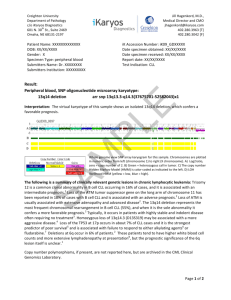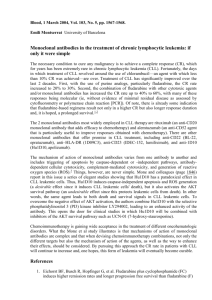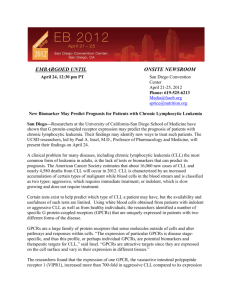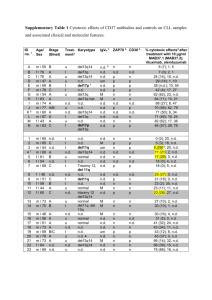example summary file
advertisement
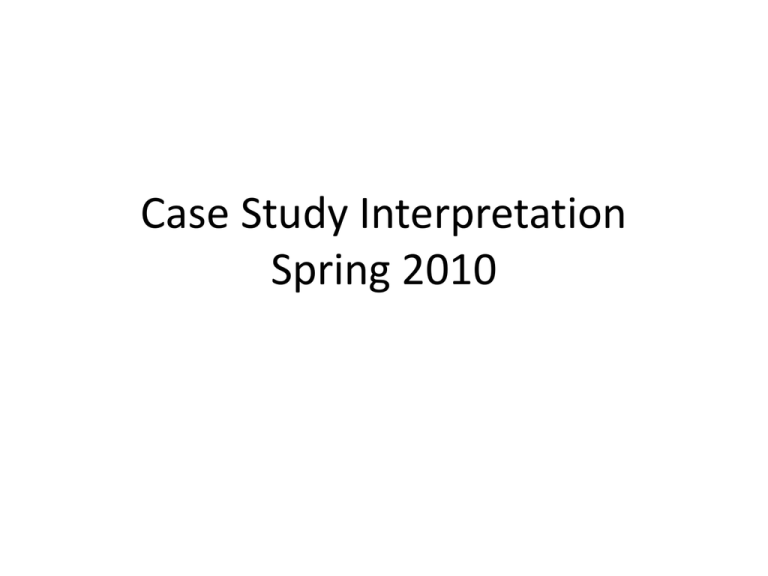
Case Study Interpretation Spring 2010 Clinical history • A 62 year old man presents to his primary care physician with lymphadenopathy. • A CBC demonstrates the following: – WBC 20.73 thousand cell/microliter • • • • • 12% neutrophils 83% lymphocytes 4%monocytes 1% eosinophils 0% basophils Peripheral blood smear 160X magnification 640X magnification 1600X magnification Wright stained peripheral blood smear Suspect CLL • The combined clinical and morphologic findings were considered suspicious for chronic lymphocytic leukemia (CLL) • A sample of peripheral blood was submitted for flow cytometry to confirm the suspected diagnosis with the following antibody combinations evaluated. – Tube 1: CD20V450 / Kappa FITC / Lambda PE / CD5 PE-Cy5 / CD19 PE-Cy7 / CD38 Alexa 594 / CD10 APC/ CD45 APC-H7 – Tube 2: FMC7 FITC/ CD23 PE/ CD19 ECD/ CD5 PE-Cy5 – Tube 3: ZAP 70 FITC/ CD38 PE/ CD19 ECD/ CD5 PE-Cy5 Flow cytometry Viable cells • Evaluation of CD45 versus side scatter demonstrated an expanded population of lymphoid cells (red arrow) • The lymphoid cells had forward and side scatter characteristics of small lymphocytes (data not shown) and consisted predominantly of an expanded population of CD19+ B-cells that coexpressed CD5 at varying levels (purple arrow) and fewer CD5+,CD19- T cells (green arrow) Lymphocytes • The B-cells were defined by CD19 expression and assessed for light chain expression Lymphocytes B-cell gate – Kappa positive B-cells are shown in blue – Lambda positive B-cells are shown in red • The majority of B-cells showed low level light chain expression with a minor subset of B-cells showing normal levels of light chain expression (arrows) • The kappa to lambda ratio was 2.7 overall B-cells • Further analysis demonstrated that the Bcells expressing low level light chain (kappa or lambda) also showed expression of low level CD20 B-cells – The B-cells expressing low CD20 and low light chain comprised the majority of the B cells and 63% of the white blood cells • Kappa 72% • Lambda 28% • The kappa expressing B-cells expressed intermediate level CD5 while the lambda expressing B-cells expressed bright CD5 • No CD10 expression was noted on this population B-cells • Both subsets of the CD20 low, CD5+ B cells expressed CD23 without FMC-7 • Additionally, both of these subsets were negative for CD38 and ZAP-70 Lymphocytes Lymphocytes Lymphocytes Lymphocytes Diagnosis Biclonal Chronic Lymphocytic Leukemia Molecular studies • • Immunoglobulin heavy chain gene rearrangement studies (using Biomed-2 primer sets) demonstrated 2-3 distinct PCR products in each of three primer sets investigated (Frameworks 1, 2, and 3) Although not entirely conclusive (cell sorting was not performed in this case), the molecular findings suggest the presence of two distinct B cell clones and are compatible with a diagnosis of biclonal CLL Chronic lymphocytic leukemia • CLL/SLL is the most common lymphoid leukemia seen in adults. • It is composed of a proliferation of clonal mature Blymphocytes expressing CD19 with CD5 and CD23. • Generally CD20 expression is low as is light chain expression. • CD10 and FMC7 are typically absent. • CLL/SLL may involve the lymph nodes and spleen but in the absence of significant extramedullary tissue involvement, the diagnosis of CLL/SLL requires demonstration of greater than or equal to 5 X 109 cells/liter (2008 WHO). Chronic lymphocytic leukemia • Light chain expression in CLL/SLL is typically monoclonal. • However, occasional cases of biclonal CLL/SLL have been described in the literature – These include Hsi et al., Chang et al., GonzalezCampos et al., and Sheikholeslami et al. • Biclonal CLL appears to occur with a frequency of approximately 3.4% (Sanchez et al) Sanchez ML, Almeida J, Gonzalez M, et al. Incidence and clinicobiologic characteristics of leukemic B-cell chronic lymphoproliferative disorders with more than one B-cell clone. Blood. 2003;102:2994-3002. • Sanchez et al. evaluated a series of 477 leukemic B cell lymphoproliferative disorders for evidence of more than one B cell clone – 53 cases showed more than 1 B-cell clone (4.8%) – Biclonality was usually suspected by: • Different light chain expression (37 of 53 cases) • Different intensity of expression of the same light chain (9 of 53 cases) – These changes were usually accompanied by other phenotypic differences – The presence of 2 clones was confirmed by molecular analysis in 44 of the 53 cases Sanchez ML, Almeida J, Gonzalez M, et al. (Table 2, page 2997) The incidence of a second clone varied based on lymphoma subtype Diagnostic group # of biclonal cases/total cases % of cases Typical CLL 12/353 3.4 Atypical CLL 4/29 13.8 Prolymphocytic leukemia 0/5 0 Hairy cell leukemia 3/13 23.1 Lymphoplasmacytic lymphoma 0/12 0 Splenic marginal zone lymphoma 1/14 7.1 Follicular lymphoma 0/22 0 Mantle cell lymphoma 1/19 5.3 Large cell lymphoma 2/10 20 Total 23/477 4.8 Clinical significance of biclonal CLL Sanchez ML, Almeida J, Gonzalez M, et al. • As compared to patients with monoclonal CLL, among patients with B-CLL having two or more clones, Sanchez et al found the following: – Lower WBC (p=0.05) – Lower absolute lymphocyte counts (p=0.01) – Greater incidence of splenomegaly (p=0.02) – Despite these differences, overall survival rates were similar between the two groups. Biclonal CLL-clinical significance for the flow cytometry laboratory • The kappa to lambda ratio alone is not enough to call a case polyclonal – In the case described herein, the overall kappa to lambda ratio was 2.7, only slightly above normal; however, the abnormal Bcells showed low level light chain expression and aberrant expression of antigens including CD5 and CD20 – Evaluation of B-cells for aberrant antigen expression by flow cytometry is critical for recognizing biclonal CLL • It is important to distinguish biclonal CLL from: – CLL co-existing with a second lymphoma (composite lymphoma) – CLL with Richter’s transformation leading to emergence of a second immunophenotypically distinct population of abnormal large B cells Incidence of biclonal MBL • A subset of healthy adults show small clonal Bcell populations that do not meet criteria for CLL/SLL. • This finding is designated monoclonal B-cell lymphocytosis (MBL) and ranges in frequency from 3.5% to 12% depending on the age of the patient population and sensitivity of the method utilized (Rawstron et al., Ghia et al., Nieto et al.). • One study suggest that as many as 19% of MBL may be bi-clonal (Nieto et al.). Summary • Biclonal CLL is a relatively common finding in the clinical flow cytometry laboratory • Recognition of this entity requires evaluation of B-cells for aberrant antigen expression even in the setting of a normal kappa to lambda ratio References • • • • • • • • • Muller-Hermelink HK, Montserrat E, Catovsky D et al. Chronic Lymphocytic Leukemia/Small Lymphocytic Lymphoma. In: Swerdlow SH, Campo E, Harris NL, et al, eds. WHO Classification of Tumors of the Hematopoietic and Lymphoid Tissues. Lyon, France: IARC Press;2008: 180-182. Sanchez ML, Almeida J, Gonzalez M, et al. Incidence and clinicobiologic characteristics of leukemic B-cell chronic lymphoproliferative disorders with more than one B-cell clone. Blood. 2003;102:2994-3002. Hsi ED, Hoeltge G, and Tubbs RR. Biclonal chronic lymphocytic leukemia. AJCP. 2000;113:798-804. Gonzalez-Campos J, Rios-Herranz E, De Blas-Orlando JM et al. Chronic lymphocytic leukemia with two cellular populations: a biphenotypic or biclonal disease. Annals of Hematology. 1997;74:243246. Chang H, and Cerny J. Molecular characterization of chronic lymphocytic leukemia with two distinct cell populations. AJCP. 2006;126:23-28. Sheikholeslami MR, Ma W, Uyeji J, et al. Bi-clonal disease in patients with chronic lymphocytic leukaemia as detected by analyzing IGHV mutation status. British Journal of Haematology. 2007;139:507-509. Rawstron AC, Green MJ, Kuzmicki A, et al. Monoclonal B lymphocytes with the characteristics of “indolent” chronic lymphocytic leukemia are present in 3.5% of adults with normal blood counts. Blood. 2002;199:635-639. Ghia P, Prato G, Scielzo C, et al. Monoclonal CD5+ and CD5- B-lymphocyte expansions are frequent in the peripheral blood of the elderly. Blood. 2004;103:2337-2342. Nieto WG, Almeida J, Romero A, et al. Increased frequency (12%) of circulating chronic lymphocytic leukemia-like B-cell clones in healthy subjects using a highly sensitive multicolor flow cytometry approach. Blood. 2009;114:33-37.


